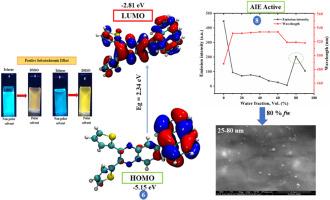Suzuki-Miyaura coupling reaction: Blue-yellow emitting AIE active dyes for organic electronics
IF 3.6
3区 物理与天体物理
Q2 OPTICS
引用次数: 0
Abstract
A series of eight novel donor‒acceptor (D─A) based 2,3-di(thiophen-2-yl)quinoxaline derivatives 2–9 were prepared by modulating donor species on quinoxaline core with Palladium catalyzed Suzuki–Miyaura ‘C–C bond’ coupling reaction. The synthesized molecules were fully characterized and studied for impact of D–A interaction on opto-electrochemical properties. Absorption spectra of 2–9 display intramolecular charge transfer (ICT) transitions in the range of 388–414 nm. Dyes shows positive solvatochromism and emit in blue‒yellow region with emission maxima 444−550 nm on excitation at their respective ICT maxima in toluene, chloroform, DCM, DMSO and neat solid film. Further, solid state emission was studied for aggregation‒induced emission (AIE) effect in THF–water system due to the nanoparticles formation, as confirmed by FEG‒SEM technique. The HOMO and LUMO energy level for compounds 2–9 were measured by cyclic voltammetry and found in the range of −5.15 to −5.94 eV and −2.81 to −3.39 eV. Theoretical studies of molecules were also carried out by using DFT and TD‒DFT calculations. The comparable HOMO and LUMO energy levels with reported ambipolar materials and efficient solid-state emission make synthesized compounds potential candidate for solid state emissive, ambipolar charge transporting materials in organic electronics.

铃木-宫浦偶联反应:用于有机电子产品的蓝黄发光 AIE 活性染料
在钯催化的铃木-米亚乌拉 "C-C 键 "偶联反应中,通过调节喹喔啉核心上的供体种类,制备了一系列基于 2,3-二(噻吩-2-基)喹喔啉的八种新型供体-受体(D─A)衍生物 2-9。对合成的分子进行了全面表征,并研究了 D-A 相互作用对光电化学特性的影响。2-9 的吸收光谱在 388-414 纳米范围内显示出分子内电荷转移(ICT)跃迁。在甲苯、氯仿、二氯甲烷、二甲基亚砜和纯固态薄膜中,染料在各自的 ICT 最大值处受到激发时,会在蓝黄区域发出 444-550 纳米的发射光。此外,还研究了在四氢呋喃-水体系中由于纳米颗粒的形成而产生的固态发射聚集诱导效应(AIE),这一点已由 FEG-SEM 技术证实。通过循环伏安法测量了化合物 2-9 的 HOMO 和 LUMO 能级,发现其范围分别为 -5.15 至 -5.94 eV 和 -2.81 至 -3.39 eV。此外,还利用 DFT 和 TD-DFT 计算对分子进行了理论研究。这些化合物的 HOMO 和 LUMO 能级与已报道的伏极性材料相当,而且具有高效的固态发射功能,因此有可能成为有机电子学中固态发射、伏极性电荷传输材料的候选化合物。
本文章由计算机程序翻译,如有差异,请以英文原文为准。
求助全文
约1分钟内获得全文
求助全文
来源期刊

Journal of Luminescence
物理-光学
CiteScore
6.70
自引率
13.90%
发文量
850
审稿时长
3.8 months
期刊介绍:
The purpose of the Journal of Luminescence is to provide a means of communication between scientists in different disciplines who share a common interest in the electronic excited states of molecular, ionic and covalent systems, whether crystalline, amorphous, or liquid.
We invite original papers and reviews on such subjects as: exciton and polariton dynamics, dynamics of localized excited states, energy and charge transport in ordered and disordered systems, radiative and non-radiative recombination, relaxation processes, vibronic interactions in electronic excited states, photochemistry in condensed systems, excited state resonance, double resonance, spin dynamics, selective excitation spectroscopy, hole burning, coherent processes in excited states, (e.g. coherent optical transients, photon echoes, transient gratings), multiphoton processes, optical bistability, photochromism, and new techniques for the study of excited states. This list is not intended to be exhaustive. Papers in the traditional areas of optical spectroscopy (absorption, MCD, luminescence, Raman scattering) are welcome. Papers on applications (phosphors, scintillators, electro- and cathodo-luminescence, radiography, bioimaging, solar energy, energy conversion, etc.) are also welcome if they present results of scientific, rather than only technological interest. However, papers containing purely theoretical results, not related to phenomena in the excited states, as well as papers using luminescence spectroscopy to perform routine analytical chemistry or biochemistry procedures, are outside the scope of the journal. Some exceptions will be possible at the discretion of the editors.
 求助内容:
求助内容: 应助结果提醒方式:
应助结果提醒方式:


